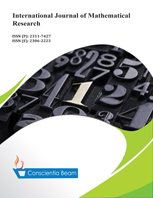MHD Flow of a Nanofluid at the Forward Stagnation Point of an Infinite Permeable Wall with a Convective Boundary Condition
DOI:
https://doi.org/10.18488/journal.24/2016.5.2/24.2.138.153Abstract
The steady magnetohydrodynamic (MHD) flow of a nanofluid at the forward stagnation point of an infinite permeable wall is investigated in this study. A mathematical model has been constructed and the governing partial differential equations are converted into ordinary differential equations by similarity transformation. The similarity equations are solved numerically by a shooting technique. Results for the surface shear stresses, surface heat transfer, and velocity, nanoparticle fraction and temperature profiles are presented in tables and in some graphs. Effects of the magnetic parameter , constant mass flux Biot number , Brownion motion parameter thermophoresis parameter and Lewis number are examined. The present results are compared with previously available numerical results obtained using other methods of solution, and they are found to be in good agreement.

